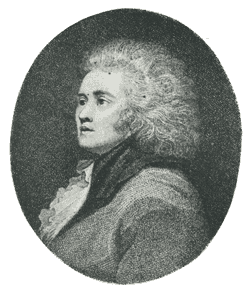William Paulet Carey, Engraver
(b. 1759, d. 1839)
Engraver
From A Dictionary of Irish Artists 1913

William Paulet Carey. Engraving.
Was born in Dublin in 1759, the son of a baker in Redmond's Hill. Having studied in the Dublin Society's School, he started as a painter but afterwards became an engraver. He brought himself into notice by his political prints, among them being one, published in 1787, of "Father O'Leary and the Presbyterian, Dr. Campbell, joining hands at the Altar of Peace." He took an active part in the stormy political events of his time, and worked industriously as an artist, a poet, and a printer. In 1789 he edited a paper called "The Miscellanist," and in 1791 commenced the publication of "The Rights of Irishmen, or the National Evening Star," which was headed by an engraving of a Protestant, a Catholic, and a Presbyterian clasping hands. The paper was written almost entirely by Carey himself; his essays appearing over the signature "Junius Hibernicus," and his poetic contributions under the name of "Scriblerus Murtough O'Pindar." These were republished with the title of "The Nettle, an Irish Bouquet to tickle the nose of an English Viceroy, &c."
He engraved in stipple many of the plates in "The Sentimental and Masonic Magazine," published by John Jones, from 1792 to 1795, and also contributed a considerable quantity ot the verse appearing therein. He also did caricatures after Bunbury for Exshaw's "London Magazine" in 1793 and 1794. A pleasing stipple print, "The Parachute," was done by him after Colibert. He joined the United Irishmen, but was expelled in 1793 "on suspicion," as the inscription on his engraved portrait says, "of being the author of the celebrated letters signed William Tell;" and after a time he found it advisable to leave the country. He was for a short time in America, and then settled in London. Owing to an accident to his eyes he had to discontinue the practice of his art, and employed himself in literature.
For some years he was a dealer in pictures, having a shop in Marylebone Street, and he assisted Sir John Fleming Leicester, afterwards Lord De Tabley, in the formation of his collection. Always devoted to art, he for more than fifty years advocated in numerous pamphlets the claims of modern and national art, and was one of the first to recognize the genius of Chantrey; and his letters to the Dublin and Cork papers first drew attention to the work of Hogan. He visited many towns in connection with his business, and in 1834 settled in Birmingham, and died there on 21st May, 1839. Carey married in 1792 a Miss Lennon of Grafton Street. His daughter, Elizabeth Sheridan Carey, was a frequent contributor to the periodicals ot the time.
His brother, John Carey, born in 1756, was an eminent classical scholar, who edited and translated many volumes of the classics, and died in 1829. Another brother, Matthew Carey, a writer and publisher, was prominently concerned in political events in Ireland, and had to leave the country in consequence. He went to America, where he was a bookseller and publisher. He was author of the "Vindiciae Hiberniae," published in 1819. He died in 1839.
Besides numerous pamphlets on political reform, William Paulet Carey published the following works on subjects connected with art:—"Thoughts on the best mode of checking the prejudices against British Works of Art," York, 1807. "A Critical Description of the Procession of Chaucer's Pilgrims to Canterbury painted by Stothard," London, 1808, 2nd ed., 1818. "Letter to J. A. (Colonel Anderson), a connoisseur in London," Manchester, 1809. "Cursory thoughts on the present state of the Fine Arts," Liverpool, 1810. "A Descriptive Catalogue of a Collection of Paintings in the possession of Sir John Fleming Leicester," 1819. "Variae; Historical Observations on anti-British prejudices, &c.," 1822. "Patronage of Irish Genius," Dublin, 1823. "The National Obstacle to the National Public Style considered," 1825. "Appeal to the Directors of the Royal Irish Institution," Dublin, 1828. "Observations on the Primary Object of the British Institution for the Promotion of the Fine Arts," Newcastle, 1829. "Brief remarks on the Anti-British effect of inconsiderate criticism on modern art and the Exhibitions of the living British Artists," London, 1831. "Some Memoirs of the patronage and progress of the Fine Arts in England and Ireland . . . . with anecdotes of Lord de Talbey," London, 1826; and others.
« John Edward Carew | Contents and Search | Thomas Carlton »
